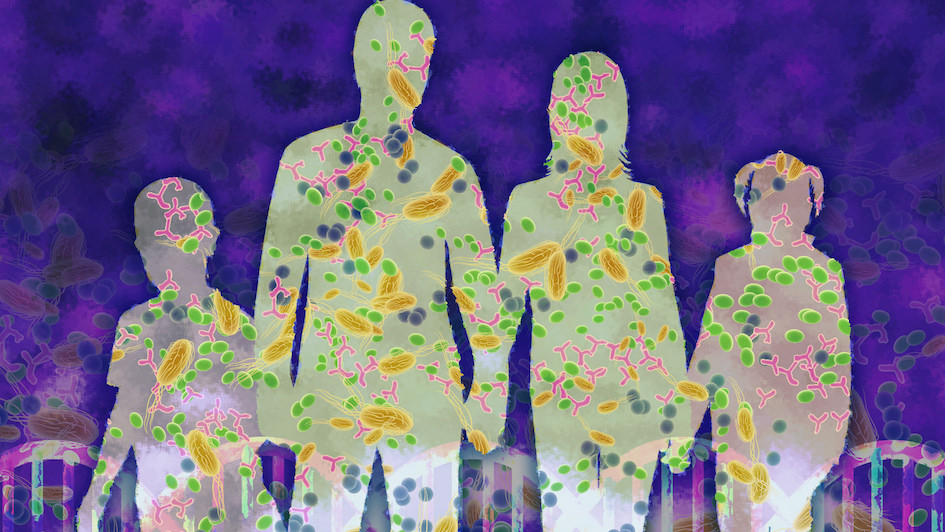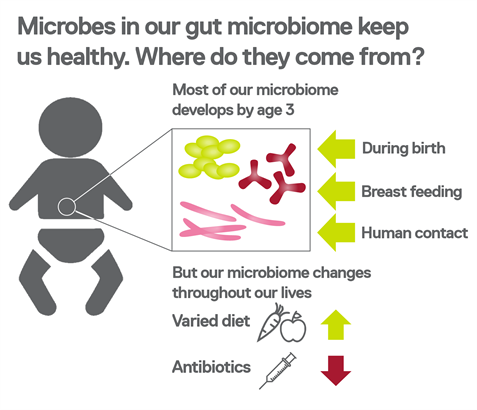
Image: The human microbiome. Credit: the National Human Genome Research Institute on Flickr, CY BY-NC 2.0
Not so many years ago had I been asked what useful function gut bacteria might have my only response would have been that they are essential for cows to digest the cellulose in grass.
How things have changed. Our intestines are now revealed as a habitat for a veritable menagerie of microbes collectively known as the microbiome, which silently control our metabolism and our immune systems. This is an evolutionary ancient symbiotic relationship that affects our health and when eroded has serious consequences, including for cancer.
Our skin, most other tissues and especially our guts are ecosystems for a plethora of small inhabitants that constitute the microbiome, including bacteriophages, viruses, bacteria, protists, worms and fungi. We only have an incomplete audit of these species but the diversity is staggering: up to 2,000 different bacterial strains or species for example.
The origins of our microbiome
Where do all these alien species come from? It turns out we acquire most of our microbiome very early in life. Many species are acquired at birth during passage through the natural, vaginal birth canal, others via breast milk and some from social contacts during infancy. Oligosaccharides in breast milk that we humans are unable to utilise are there only to feed beneficial gut bacteria.

By three years of age the complex gut microbiome community is established and reasonably stable. But throughout life it is modified, particularly by diet and by antibiotic exposure. Ground rule 1: dietary fibre good news, antibiotics bad news.
Given how the gut microbiome is acquired and modified throughout life it is not surprising that the microbiome composition varies throughout the world in association with social circumstances. In ‘third world’ countries such as New Guinea, gut microbiomes are strikingly diverse with a large worm content.
In the developed or westernised countries microbiome diversity varies greatly but is often poorly diverse. And it is this lack of diversity, a kind of evolutionary mismatch, that is now linked to many chronic diseases common in the affluent West.
Poorly diverse gut bacterial content has been associated with inflammatory bowel disease (including Crohn’s disease and ulcerative colitis), type II diabetes and obesity. Hospital-acquired infections with, for example, Clostridium difficile, are now ascribed to the impact of antibiotics in decimating the populations of benign and beneficial bacteria that normally outcompete the rarer pathological strains for space and resources in the gut.
Other possible links including with Parkinson’s disease and autism are being explored. I would take a look at the gut microbiome status of patients who react severely to covid-19 with excessive lung inflammation and sepsis.
The striking ethnic bias in severity of outcome has been attributed to the prevalence of co-morbidities, and especially obesity and diabetes, both of which are suspected as being linked to microbiome deficiencies. Might a poorly diverse gut microbiome explain both the comorbidities and the adverse or exaggerated lung inflammation with covid-19, and therefore why they track together? Worth a look I think.
Not surprising then that biotech and pharma companies are investing billions of dollars in developing microbiome therapeutics. Clinical trials are already in progress providing microbiome boosters.
How you might ask? In some cases with candidate bacterial species but in others with nothing less than a poo transplant. Yes, that’s it: we are in the golden age of precision medicine but what works here is poo, or stools.
In Boston a not-for-profit company has established a large poo bank for clinical use with more than 40,000 samples including some labelled as ‘super donors’. FDA requirements and safety concerns mean that ultimately for these treatments to be approved for widespread use there will need to be standardised preparations of well-defined and non-pathogenic bacteria.
The human microbiome and cancer
So what relevance might this all have for cancer causation and treatment? More than you might have realised. The microbiome is very likely to be playing a role in the development of gastro-intestinal tumours, especially those associated with chronic inflammation or prior inflammatory bowel disease.
It has been estimated that up to one third of human cancers are associated with chronic inflammation. Many have assumed that some as yet to be identified and very elusive viruses or bacteria are to blame. Why not a more generic problem with microbiome diversity?
It’s now becoming appreciated that a complex interplay between cancer therapy and the gut microbiome exists with implications for therapeutic efficacy and associated morbidities. Last year David Dearnaley and colleagues here at the ICR, and at Imperial College London reported that cancer patients with lower gut bacterial diversity were more likely to suffer from radiotherapy-induced gut damage or intestinal disease.
Many drugs and radiotherapy employed in cancer treatment can directly damage the immune system, rendering patients vulnerable to potentially lethal opportunistic infections. But these treatments, along with antibiotics which are frequently co-administered, also erode the gut microbiome – and that may well exacerbate immune dysfunction and contribute to other morbidities.
Patients with blood cancers given bone marrow transplants often receive tough pre-conditioning regimes coupled with antibiotics which leave the gut microbiome denuded. In some transplant centres now, at least in the US, patients scheduled for transplant have their stool samples collected and stored (at -80 degrees centigrade) to be later re-infused as an enema. Problem solved.
Recently it has become evident from both mouse modelling studies and some clinical observations that check point inhibitor immunotherapy for cancer is suboptimal in the face of microbiome deficits. Patients given new regimes of immunotherapy might be expected to benefit from the incorporation of microbiome boosters.
Immunotherapy is a revolution in cancer treatment. Donate today and help us develop therapies which use the body’s own immune system as a weapon against cancer.
Read more
The microbiome and the immune system
It is not entirely clear how bacteria and possibly other microbiome constituent species affect the immune system. But here is an outline on how it looks at present. Even seasoned immunologists view the immune system’s baroque complexity with some awe.
With some parallel to the brain, the immune system is structured as a dense network of cells and molecular signals that collectively orchestrate appropriate and balanced responses to infectious challenge.
But, again rather like the brain, the system, at birth, is not hard wired or fully operational and requires priming or training. And in an evolutionary context it makes sense that the necessary exposures for the immune network early in life occur via the ‘natural’ microbiome.
Details of how this priming mechanism may work are beginning to emerge, but key seems to be the activation of regulatory T cells, which themselves conduct the immunological orchestra. Mouse modelling suggests bacteria can do this both via metabolic products including butyrates and by direct cell contact.
And for the non-immunologists amongst you, here is, in a nutshell, a deliciously simple experiment published in Nature some two years ago that brought home the message loud and clear. Mice born and raised germ free have very immature immune systems with few regulatory T cells or mature cells of another type called effector T cells.
They also have essentially no gut microbiome. But co-house them for a month with wild or pet shop bought mice and, hey presto, their immune systems perk up to expectations, and their gut microbiomes are in place. It’s assumed these rodents’ taste for coprophagy has a lot to do with this. But you get the point. If you want something more sophisticated then essentially the same outcome has been achieved by feeding germ free mice with defined bacterial species.
I have left until last what I find the most important implications of this interplay between the microbiome and the immune system. And that is its relevance to childhood diseases that are most prevalent in developed or affluent societies. These include the most common form of childhood cancer, acute lymphoblastic leukaemia (ALL), type I diabetes and possibly other auto-immune diseases such as multiple sclerosis, and childhood allergies.
That there may be an underlying cause for these illnesses is frequently discussed under the umbrella term the ‘hygiene hypothesis’. But it’s unlikely that super cleanliness or antiseptic wipes are the problem. My view is that it’s more likely to be deficient gut microbiomes. And the possible basis for that deficiency is seen in epidemiological risk factors for these diseases including ALL: birth by cesarean section, lack of breastfeeding and a paucity of social contacts in infancy, all indicative of a likely microbiome deficit.
Our research into childhood leukaemia over the past decades has had an enormous impact on the lives of children with cancer all across the world. With your support today, we can make ALL a disease of the past.
Donate now
Boosting the microbiome to prevent cancer
Of course these various childhood illnesses have different immunopathologies and inherited risk alleles. But that disguises the intriguing possibility that they may share a common, fundamental lesion acquired very early in life: deficient immune priming, as a consequence of insufficiently diverse microbiomes, and as a consequence abnormally regulated immune responses, sometimes resulting in chronic inflammation.
This is of course speculation but the good news is that if it is correct then ALL and other very troubling conditions of childhood should be preventable. The bold ambition here is no less than population-based prophylaxis in infants – in principle, with a defined oral cocktail of immune-priming bacteria.
But before that becomes a reality, or acceptable as a public health measure, there is a need for a proof of principle demonstration in model systems. So at the ICR, with Cancer Research UK support, we have developed a mouse model for infection-driven acute lymphoblastic leukaemia in which we can directly test if boosting the microbiome in early life can prevent cancer. All power to poo!
NB: You might wonder how microbiome diversity is measured. Some advocate whole-genome sequencing coupled with appropriate, and rather challenging bioinformatics, to disentangle and identify all the microbial species distinct from each other and the human DNA in the samples.
A simpler approach is to selectively amplify a highly variable region of bacterial DNA – 16s rRNA – identify the bacterial subtypes and then apply diversity measures derived from ecology. So the critical measure is not abundance of particular species (or strains) of bacteria but the number of distinct or different bacteria.
comments powered by